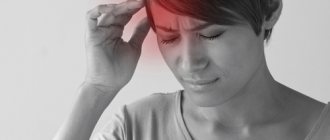Causes
Why does my head hurt? Common causes of headaches are:
- neck muscle spasm;
- compression of the vessels of the head and neck;
- compression of the membranes of the brain;
- brain nutritional disorders: insufficient blood supply, narrowing of blood vessels supplying the brain;
- smoking, poisoning with alcohol, drugs, medications;
- stress, sleep disturbance;
- due to neck and head injuries;
- birth injuries;
- anomalies in the development of blood vessels in the neck and head.
Primary headaches
| Name | Symptoms |
| Migraine | Throbbing pain in the head, most often occurring after sleep. The severity of the headache ranges from moderate to unbearable. The pain is felt on one side of the head: in the right or left temple, forehead, crown. Migraine lasts up to three days, often accompanied by nausea and vomiting. A person does not tolerate bright light and loud sounds. Migraines can be caused by stress, insomnia, or changes in weather. The tendency to migraine is inherited. |
| Tension headache (TTH) | A pressing headache covers the entire head or separately the back of the head, crown, forehead. Cephalgia can be severe. A tension headache attack can last up to 7 days. At the same time, my head hurts every day. TTH occurs due to emotional or physical stress. |
| Cluster headache | Unbearably strong shooting pain in the head. It is felt on one side, in the forehead and eye area. Cluster pain causes redness and swelling of the face and lacrimation on the pain side. Due to a severe headache, a person behaves restlessly. |
| Headache and facial pain due to trigeminal neuralgia | Very strong short-term stabbing pain in the head. The pain is felt in the crown, forehead, and can affect the face and teeth. The headache attack lasts several hours. In this case, spasm of the facial muscles may occur. |
Headache - migraine and more: why your head hurts and what to do about it
Headache - migraine and more: why your head hurts and what to do about it
Headache is probably one of the most common pain sensations in humans, both in childhood and in adults.
And it’s not for nothing that a person with a headache is called a “medical orphan.”
“He goes from an ophthalmologist to an otolaryngologist, a neurologist, a dentist, an orthopedist, a chiropractor. He is prescribed a lot of tests and
a huge number of medications, and in the end he is left alone with his headache..."
Headache (cephalgia)
- This is the most common complaint that a patient presents when visiting a doctor. And, unfortunately, he cannot always receive adequate medical care that will completely relieve him of these painful sensations.
The complexity of the problem of headache treatment
lies primarily in its pronounced etiopathogenetic heterogeneity.
In other words,
many reasons can lead to the formation of a pain syndrome
Changes in various structures
(bones, blood vessels, brain, spine, teeth, nerves, etc.) are accompanied by the same type of sensation called
headache.
The sensations may vary in intensity, localization, and frequency, but in general they significantly worsen the quality of life and in most cases require medication correction.
Relatively rarely, the causes of headaches are organic brain lesions (tumors, cysts, abscesses, inflammatory lesions of the meninges, etc.) ,
for which it is necessary to use invasive treatment methods.
In all other situations, relief (cessation) of headaches or a significant reduction in the frequency of attacks and (or) their intensity can be achieved in a conservative way using a complex of medications and additional treatment methods (physiotherapeutic, exercise therapy, massage, psychotherapeutic correction, etc.) .
But in order for the treatment to be successful
, first of all
, you need to understand what causes your headache specifically. These are not general words, since it is on this understanding that the approach to therapy is built .
Ignoring this means continuing to suffer and scolding everyone around.
The fact
that
you are
still
experiencing this pain is also your fault!
Naturally, the arguments
some,
boiling down to
the fact that
“everyone hurts”
,
“age, what do you want”
and
“this can’t be cured at all” do not stand up to any criticism
and cannot be perceived as serious.
ANY HEADACHE CAN AND SHOULD BE CURED
Causes of headache development
can be divided into several groups:
1. Inflammatory , not related to damage to the central and peripheral nervous systems
-
referred headaches
(with inflammatory processes of the paranasal sinuses and forehead - sinusitis, frontal sinuses, inflammation of the teeth, gums, bone structures of the upper and lower jaw, inflammation of the ear structures - otitis, inflammation of the salivary, lacrimal, thyroid glands, structures of the eyeball).
With all these processes, headache
is a complication of the main process and is completely relieved when it is cured
.
Painful sensations in the head are always accompanied by similar sensations in an inflammatory organ or tissue. When the acute inflammatory process passes into the chronic stage, only cephalgic syndrome (i.e. headache) often remains.
2. Inflammatory , associated with damage to the structures of the central and peripheral nervous systems
(acute lesions of the nerve trunks - neuritis, neuralgia, chronic degenerative-inflammatory changes in the nerve trunks - neuropathy, lesions of the membranes of the brain - meningitis, arachnoiditis, damage to the substance of the brain - encephalitis, meningoencephalitis, abscesses).
In these processes, headache
is one of the syndromes of a serious illness and is accompanied by a complex of objective neurological symptoms.
The mechanism of headache formation in these cases is multifactorial and includes: irritation of the meninges against the background of increased intracranial pressure, tension or dilation of cerebral vessels, pressure on pain-sensitive structures, hyperpulsation in the affected nerve trunks, etc. In all cases, along with other pathogenetic mechanisms of headache formation, a psychogenic one .
At the same time, psychogenic headaches exist both at the acute stage of the disease and at the stage of residual changes, taking into account the psychotraumatic effect of any infectious disease of the nervous system.
3. Tension headaches.
This type of headache is the most common and is associated with prolonged static load on the cervical spine. The headache is realized through irritation of the structures of the sympathetic nerve plexus of the vertebral artery at the level of the C5-C7 vertebrae, as well as irritation of the C2-C3 spinal cord roots. Involutional, degenerative, post-traumatic changes in the cervical spine contribute to such reactions. In these situations, headaches have a rather characteristic localization in the occipital region, “encompassing”, squeezing the head like a “helmet”. Often there is palpation pain in the cervical spine, a feeling of stiffness in the neck muscles, subjective limitation of neck mobility, possible sensations of tingling, “crawling goosebumps”, and burning in the occipital region.
4. Psychogenic headaches
. This type of headache is provoked by psycho-emotional stress of various origins, both as part of physiological reactions (to various everyday situations, changes in health, etc.), and as one of the manifestations of a mental disorder (schizophrenia, manic-depressive psychosis, obsessional neurosis and etc.). The nature of psychogenic headaches can vary significantly - from local, spastic, pulsating to diffuse, diffuse.
5. Headaches associated with cerebral vascular reactions.
The causes of arterial vascular headaches can be various conditions accompanied by dilation of the lumens of the carotid and vertebral arteries at the extracranial level, as well as large arteries of the base of the brain (middle, anterior, posterior cerebral arteries). The main ones are: lowering blood pressure, administration of medications that cause polysegmental vasodilator reactions (nitroglycerin, papaverine, etc.), acute thrombosis or thromboembolism in large arterial trunks, increased intracranial pressure, accompanied by stretching of the walls of the deep veins of the brain, irritation of the brain shells. Headaches of this origin are constant, varying in intensity, and are often described by patients as a feeling of heaviness in the head with a predominance in the forehead and brow ridges. “Venous” headaches predominate in the morning and are accompanied by pastiness (swelling) of the upper half of the head and forehead.
6. Migraine
-
a special type of headache
, the development of which is based on a complex of pathological changes in various parts of the human body, including hormonal disorders of various origins (associated with pathology of the pelvic organs, thyroid gland, pituitary gland, hypothalamus, taking hormonal drugs, including contraceptives, etc.). d.), disorders of neurogenic regulation of vascular tone, the presence of pathological activity of brain neurons.
Migraine
- painful, usually long-term, systematically recurring attacks of headache -
is a paroxysmal condition .
In this regard, it can be classified as so-called “minor” epilepsy. A migraine attack in different people is provoked by different factors, but its clinical course is usually quite the same.
The main provoking factors include:
-increased blood pressure
-psycho-emotional load
-fluctuations in hormone levels in the second phase of the menstrual cycle
- drinking alcohol (especially red wine)
- fluctuations in atmospheric pressure.
Moreover, each of these factors in one way or another provokes the development of a spastic reaction of the cerebral arteries and subsequently initiates the first phase of a migraine attack.
In its development, a migraine attack goes through four phases:
1st phase
spastic (cerebral arteries narrow), not accompanied by headache;
2nd and 3rd phases
- dilator (cerebral arteries paralytically dilate), underlying a painful attack of headache
4th phase
- stage of residual (residual) changes (the tone of the cerebral arteries gradually returns to its original state).
In the first phase
During an attack, a variety of symptoms may appear (visual, coordination, motor, etc.), which are short-term in nature and completely reversible. This type of migraine is called migraine with aura.
In the second and third phases
attack, intense headaches develop, often of the hemicrania type (pain in half of the head), behind the eye, while it is painful to touch the scalp, photophobia, nausea, vomiting may be observed, and loud sounds are irritating.
After the attack ends
migraine develops weakness and drowsiness. During the interictal period, there are no objective clinical signs of the disease.
The process of examining and identifying the causes of headaches is even more complicated.
in every patient with cephalgia. This is explained by the fact that in the vast majority of patients, the causes of headaches are functional in nature and do not lead to visible structural changes either in the brain itself and its vascular system, or in the structures and tissues adjacent to them.
obvious
only when the patient has identified, according to imaging techniques, volumetric brain lesions, post-traumatic changes, signs of damage to the meninges, signs of inflammatory lesions of the paranasal sinuses and other organic processes of cerebral and precerebral localization.
In other situations
, in which
tension headaches and psychogenic headaches
, as well as
migraines
, there are no visible changes in the substance of the brain. The signs of damage to the vascular system and spinal column revealed are most often of a nonspecific nature.
Certain diagnostic information
can provide
a study of vessels and blood flow indicators in their lumens
at extra- and intracranial levels, as well as an assessment of flows in the deep veins of the brain.
In this case, not only background studies are important, but also reactions to stress testing
, which make it possible to assess the presence of regulatory tonic states caused by both fluctuations in systemic blood pressure and secondary extravasal effects, for example, from bone structures.
The optimal diagnostic method for these purposes is ultrasound, namely duplex scanning of extra- and intracranial segments of the brachiocephalic arteries with functional stress tests of myogenic and metabolic orientation.
To identify structural changes in the brain and bone formations
etc.
The optimal diagnostic method is magnetic resonance imaging of the brain
(if necessary, with contrast enhancement).
Verification of changes in the cervical spine, which often provoke headache syndrome, is carried out using magnetic resonance imaging
or
computed tomography.
To prescribe adequate treatment
patients with migraine sometimes require
electroencephalography
, which makes it possible to objectify disturbances in the bioelectrical activity of the brain that contribute to the occurrence of paroxysmal conditions.
At the same time, everyone seeking help for a headache should know that any instrumental and laboratory examination that is proposed to be carried out is absolutely useless if its results are not assessed by a competent clinician (neurologist) who is able to fully analyze the existing disorders and prescribe an individualized ( course of treatment that is right for you.
At the Multidisciplinary Professorial Medical Center, we offer only similar approaches to patients with headaches.
The diagnostic search is aimed at excluding organic causes of its occurrence and establishing the mechanism of development.
Treatment is selected individually; “template” schemes are not used. Therapy is prescribed only taking into account general pathological changes - the presence (absence) of arterial hypertension, metabolic syndrome, and other pathological processes.
What does MPMC "Vascular Clinic on Patriarch's" offer for headaches?
At the Vascular Clinic on Patriarch's Medical Center, we offer a full examination for people with headaches, including:
ultrasound examinations of the heart,
any vessels (aorta, neck and brain vessels, lower extremities, renal arteries, etc.),
vascular reactivity,
functions of the vascular endothelium,
properties of the vascular wall,
a set of laboratory tests, including hormonal status;
electrocardiography,
Holter monitoring ECG,
daily monitoring of blood pressure levels.
If necessary, in the conditions of an agent clinic, any computed tomography and magnetic resonance procedures can be performed for clients of our center.
We also offer an absolutely unique method, used only in large scientific centers -
transcranial Doppler monitoring with microembolodetection (the only method for intravital verification of embolism in cerebral vessels).
Our leading specialists - professors and doctors with extensive scientific and practical experience - will select the optimal therapy for your child.
We offer you consultations from the best specialists:
Lelyuk Svetlana Eduardovna
– neurologist, angiologist – teenagers from 15 years old
Malmberg Sergei Alexandrovich
– pediatric neurologist, neurophysiologist – children of any age
Ramazanov Ganipa Ramazanovich
– neurologist – adults
For in-depth examinations, our clinic has special patient examination programs for the prevention of stroke and acute coronary syndrome.
If you or your child has headaches, contact us.
We will conduct an examination and prescribe treatment.
We have every opportunity for early detection of signs of various vascular diseases.
We are ready to select effective therapy for both prevention and treatment of complications.
At your service are modern medications at reasonable prices in our pharmacy.
You can find out all the details by going to the relevant sections of the site or by calling or.
We will be glad to see you in our clinic.
Secondary
Secondary headaches can be a sign of other diseases. Most often it is caused by the following diseases:
| Cause of headache | Manifestations of the disease |
| Cervical osteochondrosis | Headache appears with a sharp turn of the head, prolonged neck tension, or an uncomfortable position of the head during sleep. The pain intensifies in the morning, often spreading to one side of the head. May be accompanied by hearing loss in one ear, tinnitus, and spots before the eyes. |
| Flu or cold | The headache is not very severe, localized in the forehead, eyes, temples on one or both sides. In addition to the headache, the patient’s temperature rises above 37 degrees, a runny nose, cough, sore throat and other cold symptoms appear. |
| Increased intracranial pressure | Prolonged frequent headaches are combined with nausea and vomiting. A person often feels sick in the morning. If these symptoms and mild headaches occur, you should consult a doctor. |
| Brain concussion | The headache may last for several years after the injury. Accompanied by anxiety, irritability, decreased concentration, and dizziness. The person may suffer from depression. |
| Vegetovascular dystonia | Causes dizziness, nausea, neurotic disorders, and surges in blood pressure. Exacerbations occur with weather changes and emotional overload. |
| Hypertonic disease | A bursting headache is felt in the back of the head. Combined with heat in the head, dizziness, noise in the head, spots before the eyes, staggering. A person may feel nausea and heart pain. |
| Sinusitis, sinusitis, sinusitis | Chronic long-term pressing headaches in the forehead, eyes, cheeks. Accompanied by nasal congestion, runny nose, and slight fever. |
| Horton's headache | Characterized by attacks of severe boring pain. It spreads around the eye, temple and forehead. The attacks usually occur at the same time. This type of headache is more common in men. |
| Hypertonic disease | A bursting headache is felt in the back of the head. Combined with heat in the head, dizziness, noise in the head, spots before the eyes, staggering. A person may feel nausea and heart pain. |
Prevention methods
Sharp pain in the head is a symptom of a number of disorders, which are often acquired. This means that they are easy to prevent if you follow the recommendations of doctors:
- give up bad habits - they form toxins that adversely affect brain cells;
- exclude from the diet fatty foods, sweets, salt and spices in large quantities, fast food;
- carry out moderate physical activity - it is important to maintain muscle tone to prevent diseases of the cervical spine;
- normalize your sleep schedule.
The Clinical Brain Institute specializes in the diagnosis and treatment of diseases that manifest as severe headaches. Our center has modern equipment for conducting complex examinations, and our doctors have extensive experience in treating head pain. For most patients, it is enough to follow the recommendations at home, but the center offers the possibility of comfortable placement in a hospital.
When you can't put off visiting a doctor
- For an acute headache that suddenly arose and resembles “a blow to the head.” This may be a symptom of subarachnoid hemorrhage. Call an ambulance immediately.
- The pain intensifies when lying down and goes away half an hour after getting out of bed. This is a sign of impaired outflow of cerebrospinal fluid, increased intracranial pressure, and a tumor.
- If the headache appears regularly, is intense, is associated with changes in body position and changes with movement.









